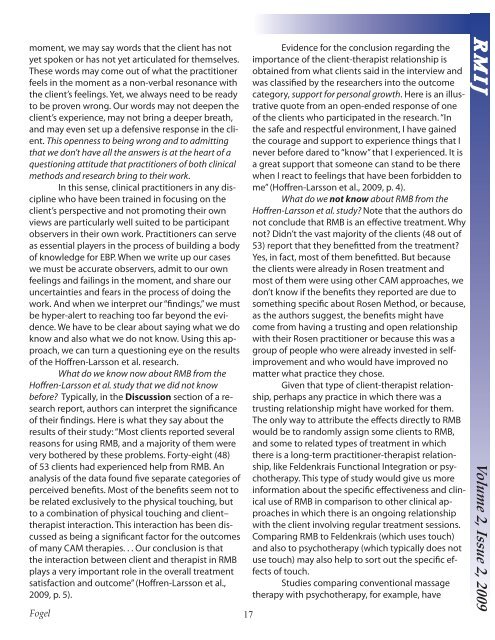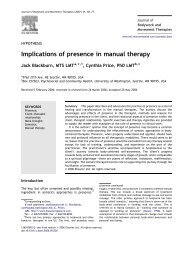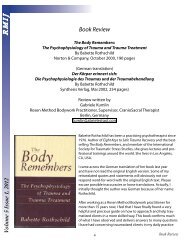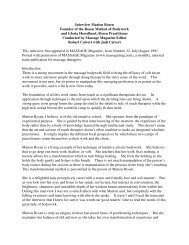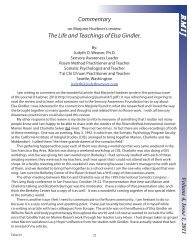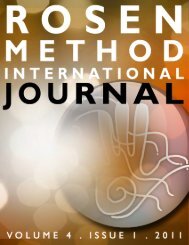RMIJ ... - Rosen Journal
RMIJ ... - Rosen Journal
RMIJ ... - Rosen Journal
Create successful ePaper yourself
Turn your PDF publications into a flip-book with our unique Google optimized e-Paper software.
moment, we may say words that the client has not<br />
yet spoken or has not yet articulated for themselves.<br />
These words may come out of what the practitioner<br />
feels in the moment as a non-verbal resonance with<br />
the client’s feelings. Yet, we always need to be ready<br />
to be proven wrong. Our words may not deepen the<br />
client’s experience, may not bring a deeper breath,<br />
and may even set up a defensive response in the client.<br />
This openness to being wrong and to admitting<br />
that we don’t have all the answers is at the heart of a<br />
questioning attitude that practitioners of both clinical<br />
methods and research bring to their work.<br />
In this sense, clinical practitioners in any discipline<br />
who have been trained in focusing on the<br />
client’s perspective and not promoting their own<br />
views are particularly well suited to be participant<br />
observers in their own work. Practitioners can serve<br />
as essential players in the process of building a body<br />
of knowledge for EBP. When we write up our cases<br />
we must be accurate observers, admit to our own<br />
feelings and failings in the moment, and share our<br />
uncertainties and fears in the process of doing the<br />
work. And when we interpret our “findings,” we must<br />
be hyper-alert to reaching too far beyond the evidence.<br />
We have to be clear about saying what we do<br />
know and also what we do not know. Using this approach,<br />
we can turn a questioning eye on the results<br />
of the Hoffren-Larsson et al. research.<br />
What do we know now about RMB from the<br />
Hoffren-Larsson et al. study that we did not know<br />
before? Typically, in the Discussion section of a research<br />
report, authors can interpret the significance<br />
of their findings. Here is what they say about the<br />
results of their study: “Most clients reported several<br />
reasons for using RMB, and a majority of them were<br />
very bothered by these problems. Forty-eight (48)<br />
of 53 clients had experienced help from RMB. An<br />
analysis of the data found five separate categories of<br />
perceived benefits. Most of the benefits seem not to<br />
be related exclusively to the physical touching, but<br />
to a combination of physical touching and client–<br />
therapist interaction. This interaction has been discussed<br />
as being a significant factor for the outcomes<br />
of many CAM therapies. . . Our conclusion is that<br />
the interaction between client and therapist in RMB<br />
plays a very important role in the overall treatment<br />
satisfaction and outcome” (Hoffren-Larsson et al.,<br />
2009, p. 5).<br />
Fogel<br />
17<br />
Evidence for the conclusion regarding the<br />
importance of the client-therapist relationship is<br />
obtained from what clients said in the interview and<br />
was classified by the researchers into the outcome<br />
category, support for personal growth. Here is an illustrative<br />
quote from an open-ended response of one<br />
of the clients who participated in the research. “In<br />
the safe and respectful environment, I have gained<br />
the courage and support to experience things that I<br />
never before dared to ‘‘know’’ that I experienced. It is<br />
a great support that someone can stand to be there<br />
when I react to feelings that have been forbidden to<br />
me” (Hoffren-Larsson et al., 2009, p. 4).<br />
What do we not know about RMB from the<br />
Hoffren-Larsson et al. study? Note that the authors do<br />
not conclude that RMB is an effective treatment. Why<br />
not? Didn’t the vast majority of the clients (48 out of<br />
53) report that they benefitted from the treatment?<br />
Yes, in fact, most of them benefitted. But because<br />
the clients were already in <strong>Rosen</strong> treatment and<br />
most of them were using other CAM approaches, we<br />
don’t know if the benefits they reported are due to<br />
something specific about <strong>Rosen</strong> Method, or because,<br />
as the authors suggest, the benefits might have<br />
come from having a trusting and open relationship<br />
with their <strong>Rosen</strong> practitioner or because this was a<br />
group of people who were already invested in selfimprovement<br />
and who would have improved no<br />
matter what practice they chose.<br />
Given that type of client-therapist relationship,<br />
perhaps any practice in which there was a<br />
trusting relationship might have worked for them.<br />
The only way to attribute the effects directly to RMB<br />
would be to randomly assign some clients to RMB,<br />
and some to related types of treatment in which<br />
there is a long-term practitioner-therapist relationship,<br />
like Feldenkrais Functional Integration or psychotherapy.<br />
This type of study would give us more<br />
information about the specific effectiveness and clinical<br />
use of RMB in comparison to other clinical approaches<br />
in which there is an ongoing relationship<br />
with the client involving regular treatment sessions.<br />
Comparing RMB to Feldenkrais (which uses touch)<br />
and also to psychotherapy (which typically does not<br />
use touch) may also help to sort out the specific effects<br />
of touch.<br />
Studies comparing conventional massage<br />
therapy with psychotherapy, for example, have<br />
<strong>RMIJ</strong> Volume 2, Issue 2, 2009


